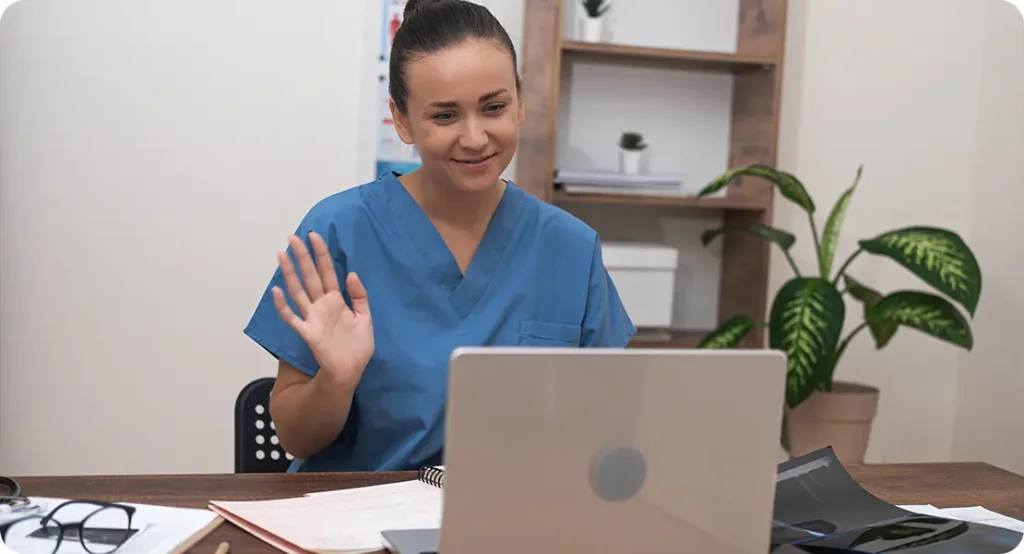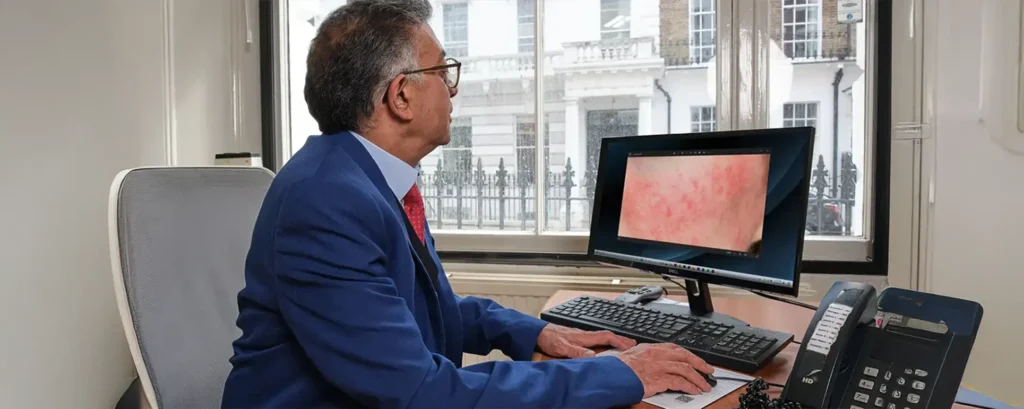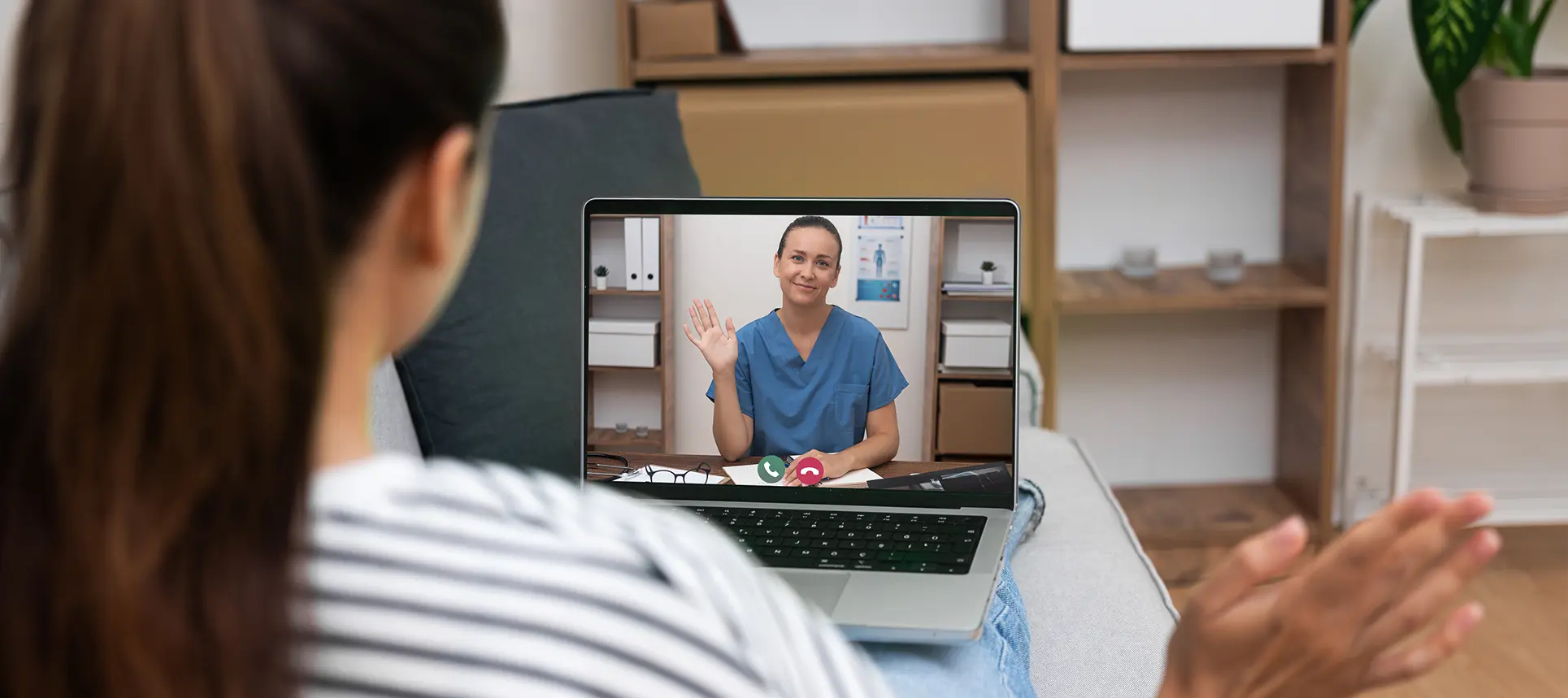If you’ve already had an initial consultation with a private dermatologist, you might be asking yourself: Do I really need to return to the clinic every time for follow-up care? Whether you’re managing a long-term skin condition like acne, eczema, or psoriasis, or monitoring results from a treatment like laser therapy or a skin biopsy, repeated in-person visits may not always be necessary.
The good news is no, not always. Many private dermatology clinics in London, including our expert team at The London Dermatology Centre, now offer the option of virtual follow-up appointments. This method of remote care, commonly known as teledermatology, has become increasingly popular in recent years and is especially helpful for busy patients, parents, or anyone who prefers the convenience of receiving expert advice from the comfort of their own home.
Virtual follow-ups are a practical and efficient way to stay on top of your treatment plan, ask questions about side effects or progress, and receive updated prescriptions all without needing to physically visit the clinic. These appointments can often be booked sooner than in-person ones, and they allow patients to avoid travel time, traffic, and long waiting periods.
In this guide, I’ll walk you through everything you need to know about virtual follow-ups with a private dermatologist in London when they’re appropriate, how they work, what the experience is like, and how to prepare for one to get the most out of your time.
What Is a Virtual Dermatology Follow-Up?
A virtual dermatology follow-up is a scheduled medical appointment that takes place remotely, without you needing to visit the clinic in person. Instead of sitting in a consultation room, you’ll connect with your dermatologist using digital tools. These virtual follow-ups are ideal for patients who have already had an in-person consultation and are now continuing care under a treatment plan.
There are several formats your virtual follow-up might take, depending on your condition and what your dermatologist needs to review:
- Secure video consultation – This is the most common format. It’s typically done via Zoom, Microsoft Teams, or another secure, clinic-approved platform. You’ll speak with your dermatologist face-to-face over video, much like a standard consultation, but from the comfort of your home or office.
- Photo submission with written feedback – For certain skin conditions that don’t require real-time discussion, your dermatologist may ask you to upload high-quality photos of the affected area. They’ll then review these images and send you written advice, treatment updates, or any necessary prescriptions via email or your patient portal.
- Telephone consultation – If a visual assessment isn’t needed for example, when discussing side effects, reviewing blood test results, or checking in on how you’re feeling after starting a new medication a phone call may suffice. This is especially helpful if you’re on the go or have limited internet access.
The main goal of a virtual follow-up is to ensure continuity of care in a convenient, time-saving way. These appointments work best in situations where a physical examination isn’t required, such as:
- Reviewing your response to a prescribed cream, tablet, or treatment
- Adjusting medications or dosages based on your progress or side effects
- Checking on the healing of a minor procedure (e.g. after mole removal or biopsy)
- Answering follow-up questions or clarifying next steps
- Discussing laboratory results or imaging scans
By choosing a virtual follow-up, you get professional guidance without needing to take extra time off work, navigate public transport, or rearrange your schedule. It’s a modern, flexible way to continue treatment especially useful for people managing chronic skin conditions that require regular monitoring.
When Is a Virtual Follow-Up Suitable?

While virtual follow-ups are incredibly convenient, they’re not suitable for every dermatological condition. In cases where a hands-on examination or biopsy is required, an in-person visit may still be necessary. However, for many common skin concerns and treatment reviews, remote care can be just as effective and much more accessible.
Here are some of the most common scenarios where a virtual dermatology follow-up is appropriate:
- Acne
Virtual reviews work well for patients using prescribed topical or oral treatments. Your dermatologist can assess how your skin is responding to medications, check for any side effects such as dryness or irritation, and make dosage adjustments if needed. These appointments are especially useful for those on isotretinoin, where regular monitoring is required. - Eczema or Psoriasis
Chronic conditions like eczema and psoriasis often require ongoing care. A virtual check-in allows your dermatologist to review flare-ups, monitor how your skin is responding to moisturisers, topical steroids, or phototherapy, and tweak your treatment plan without the need for another clinic visit. - Hyperpigmentation or Scarring
If you’re undergoing treatment for pigmentation issues or acne scarring such as using lightening creams, retinoids, or undergoing mild chemical peels your progress can typically be tracked remotely through photo submissions and virtual discussions. - Post-Procedure Recovery
After undergoing minor procedures like mole removal, cryotherapy, or laser treatments, your dermatologist may only need to see how well the area is healing. This can often be done via high-resolution photos or a quick video call, saving you the time and effort of returning to the clinic. - Prescription Review
For patients on long-term medication, such as antibiotics, antifungals, or treatments for rosacea or acne, virtual follow-ups are ideal. They help ensure that the medication remains effective and safe over time, and allow the dermatologist to renew prescriptions or suggest changes if needed.
Overall, virtual follow-ups are best suited for stable or ongoing conditions where visual assessment is sufficient. They offer a fast, efficient, and patient-friendly way to stay on top of your skin health without interrupting your daily routine.
How Does the Process Work?
If you’ve never had a virtual dermatology appointment before, you might be unsure of what to expect. Fortunately, the process is simple, straightforward, and designed to be as seamless as possible for patients.
Here’s how a typical virtual follow-up unfolds, step by step:
- Step 1: Request the Appointment
Start by contacting your clinic either by phone, email, or through their website to request a virtual follow-up. Let them know the reason for your consultation and whether you’ve had a previous appointment with the same dermatologist. The clinic will then schedule your session and send over all the necessary details, including the date, time, and the platform they’ll use (e.g. Zoom, Microsoft Teams, or a secure clinic portal). - Step 2: Submit Photos (if required)
Depending on your skin concern, your dermatologist may ask you to upload clear, high-resolution photos before the appointment. This is particularly useful for conditions like acne, eczema, or hyperpigmentation, where close-up visual assessment helps track progress. Make sure you take these photos in natural light, using a clean lens and a neutral background, to ensure your skin is clearly visible. - Step 3: Attend the Virtual Appointment
On the day of your consultation, log in to the secure platform a few minutes before your scheduled time. Ensure your internet connection is stable and that your device’s camera and microphone are working. During the session, you’ll speak directly with your dermatologist, just as you would in person. They may ask you to describe any symptoms, show specific areas of concern via video, or provide updates on your treatment experience so far. - Step 4: Review and Adjust
Your dermatologist will assess your condition based on your description and submitted visuals, then decide whether your current treatment should continue as is or be adjusted. They might recommend a new medication, tweak your dosage, or offer lifestyle tips to support your recovery. This stage is also your chance to ask any questions or raise concerns about how your skin has been reacting. - Step 5: Aftercare Plan
After the appointment, you’ll receive a follow-up email summarising your treatment plan. This may include updated prescriptions, skincare instructions, reminders about side effects to watch for, and guidance on when to schedule your next review. Some clinics also provide access to a secure patient portal where all your records, advice, and prescriptions are stored for easy reference.
The entire process is designed to be efficient and patient-friendly, often taking just 15–20 minutes. It removes the need for commuting, parking, or waiting rooms making it easier to stay consistent with your dermatological care, even on a tight schedule.
Are Virtual Follow-Ups as Effective?

In many situations, yes virtual dermatology follow-ups can be just as effective as in-person visits, particularly when it comes to ongoing treatment and routine check-ins.
Research has consistently shown that teledermatology is a reliable alternative to face-to-face appointments for a wide range of conditions. For example, a study published in the Journal of the American Academy of Dermatology found that virtual consultations were comparable in clinical accuracy and patient outcomes to traditional reviews provided the issue didn’t require a physical examination, skin scraping, or biopsy.
The main advantage of virtual follow-ups is improved accessibility. You’re not waiting weeks for an appointment slot or travelling across the city to get expert advice. This is especially beneficial if:
- You have a chronic skin condition that requires regular monitoring
- You’re on a long-term prescription like isotretinoin or antibiotics that need dose adjustments
- You’ve recently undergone a minor procedure and only need the area visually assessed
- You’re experiencing a flare-up and want rapid support without delay
By making dermatological care more convenient, virtual appointments can actually increase patient adherence to treatment plans. People are more likely to follow through with their skincare routines, refill prescriptions, and ask questions when the process is hassle-free.
That said, not every case is suitable for virtual care. If you’re dealing with a new, undiagnosed rash, a suspicious mole, or a condition that may require lab tests or a biopsy, an in-person visit will likely be the better and safer option. A reputable dermatologist will always advise you on what’s most appropriate based on your specific needs.
What If My Condition Gets Worse?
Virtual appointments are a great tool for monitoring your skin, but they do have limits. If your condition changes unexpectedly such as a sudden flare-up, the appearance of new or worsening symptoms, or any signs of infection like swelling, oozing, or increasing pain it may no longer be appropriate to continue care remotely.
In these situations, your dermatologist will typically recommend an in-person review. This allows for a closer physical examination and, if necessary, additional tests such as a biopsy, swab, or dermatoscopic assessment. It also gives your consultant the opportunity to revise your treatment plan in real time and provide immediate hands-on care.
At The London Dermatology Centre, patient safety is always our top priority. If there’s any doubt about your skin’s condition or if we feel that remote care may not give us the full picture, we won’t hesitate to invite you in for a face-to-face consultation. Our aim is to ensure that you receive the most appropriate and effective treatment whether that’s online or in the clinic.
By combining virtual and in-person care when needed, we’re able to offer you a flexible, responsive, and safe dermatology experience that evolves with your skin’s needs.
Is a Virtual Follow-Up Cheaper?
In many private dermatology clinics, virtual follow-up appointments tend to be slightly more affordable than traditional in-person visits. This is largely because remote consultations require fewer clinic resources there’s no need for a physical exam room, support staff, or on-site equipment. For that reason, clinics can often pass on some of those savings to patients.
That said, the actual cost can vary depending on the provider, the complexity of your condition, and the length of the consultation. Some clinics may charge the same rate for both formats, especially if the appointment involves reviewing complex treatments, long-term medications, or multiple skin concerns. Others may offer bundled packages for ongoing care, which include a mix of in-person and virtual appointments at a discounted rate.
At The London Dermatology Centre, we aim to provide transparent pricing and flexible options so you can choose what works best for your needs and budget. If you’re considering a virtual follow-up, it’s always a good idea to contact the clinic in advance to confirm the cost, what’s included, and whether any additional fees apply (e.g. for prescriptions or digital letters).
While saving money is certainly a bonus, many patients choose virtual consultations not just for affordability but also for convenience, time efficiency, and ease of access to ongoing expert care.
Will Insurance Cover It?

Yes many private health insurance providers do cover virtual dermatology follow-ups, especially when they form part of a recognised or ongoing treatment plan. However, coverage can vary depending on your individual policy, the insurer, and the specific terms of your agreement.
To avoid any surprises, it’s a good idea to take the following steps before booking your virtual appointment:
- Check with your insurance provider directly
Reach out to your insurer to confirm whether teledermatology is included in your policy. Some plans now treat virtual and in-person consultations equally, while others may only reimburse certain types of remote appointments. - Clarify which formats are eligible
Ask whether the insurer covers video consultations, photo-based reviews, or telephone calls. Some providers require a real-time video call for coverage, while others accept asynchronous formats like image submissions followed by written advice. - Confirm referral requirements
Depending on your insurer, you may still need a GP referral, even for a follow-up consultation. If you’re unsure, it’s worth asking whether a new referral is necessary or if your original one remains valid for multiple sessions. - Understand coverage limits
Some policies may only allow a set number of consultations per year or may cap the reimbursement amount per session. It’s best to clarify these limits in advance to manage your expectations.
If you’re not using private insurance and instead choosing to self-pay, most private clinics including The London Dermatology Centre will provide a clear price quote upfront. This typically includes details about what the virtual appointment covers, how long it will last, and whether prescription costs are included.
Overall, virtual follow-ups are becoming increasingly accepted by insurers and are seen as a valid, cost-effective form of specialist care. As demand for telehealth continues to grow, more providers are updating their policies to reflect this shift.
Final Thought: Making Dermatology More Accessible
If you’re juggling a busy schedule or simply prefer to stay at home, virtual follow-ups are a great way to continue your skincare journey without disruption.
Reach out to us to schedule a consultation with one of our experienced dermatologists in London. Whether you’re managing acne, following up on a procedure, or simply want to review a prescription, our secure teledermatology options make it easier to stay on top of your skin health.
References:
- Verma, L., Turk, T., Dennett, L. & Dytoc, M. (2024) Teledermatology in atopic dermatitis: a systematic review. Journal of Cutaneous Medicine and Surgery, published online 11 January 2024. doi:10.1177/12034754231223694. Available from: https://doi.org/10.1177/12034754231223694
- Chow, A. et al. (2024) Teledermatology: an evidence map of systematic reviews. Systematic Reviews, 13:258. Available from: https://systematicreviewsjournal.biomedcentral.com/articles/10.1186/s13643-024-02655-5
- Finnegan, O.J. et al. (1998) Comparison of teleconsultations and face‑to‑face consultations in dermatology. British Journal of Dermatology, 139(2):356–360. doi:10.1046/j.1365-2133.1998.02318.x. PubMed PMID: 9764153. Available from: https://pubmed.ncbi.nlm.nih.gov/9764153
- Perera, E. et al. (2021) Teledermatology in the COVID‑19 pandemic: a systematic review. Journal of the American Academy of Dermatology International, 2021. Available from: https://www.jaadinternational.org/article/S2666-3287(21)00057-2/fulltext
- Beer, J. et al. (2020) Teledermatology: current indications and considerations for future use. Archives of Dermatological Research, 312:609–620. Available from: https://link.springer.com/article/10.1007/s00403-020-02145-3
